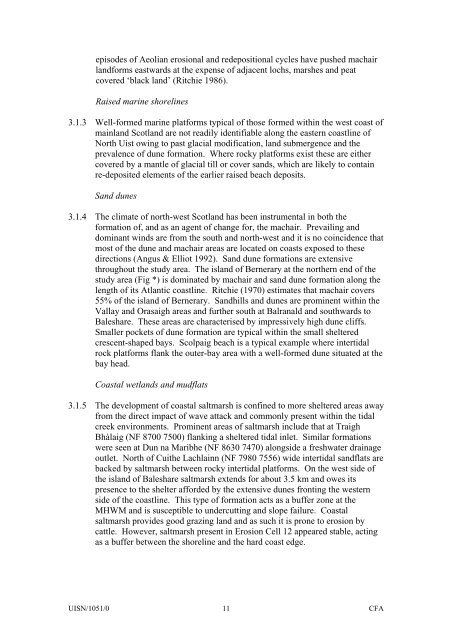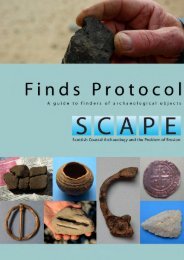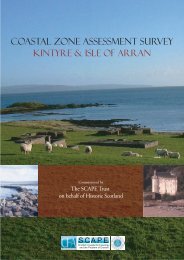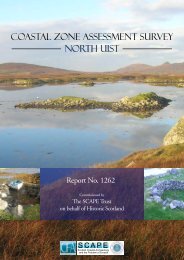- Page 1 and 2: COASTAL ZONE ASSESSMENT SURVEYnorth
- Page 3 and 4: CONTENTS1. Introduction 42. Methodo
- Page 5 and 6: 1. INTRODUCTION1.1 Background1.1.1
- Page 7 and 8: incorporation into a GIS database t
- Page 9 and 10: 2.5.2 The GIS database incorporates
- Page 11: 3. THE PHYSICAL ENVIRONMENT OF THE
- Page 15 and 16: 4. ARCHAEOLOGICAL BACKGROUND OF THE
- Page 17 and 18: Industrial Period4.11 There are ver
- Page 19 and 20: MAP 1: HINTERLAND GEOLOGY AND COAST
- Page 21 and 22: MAP 1: EROSIONID Name of coastal se
- Page 23 and 24: MAP 1: BUILT HERITAGE AND ARCHAEOLO
- Page 25 and 26: ID Name NMRS No. Source NGR Status
- Page 28 and 29: MAP 2: RUBH’ A’ CHORRAIN TO BER
- Page 30 and 31: NORTH UIST MAP 2 - HINTERLAND GEOLO
- Page 32 and 33: NORTH UIST MAP 2 - EROSION CLASSRub
- Page 34 and 35: NORTH UIST MAP 2 - BUILT HERITAGE A
- Page 36 and 37: MAP 3: HINTERLAND GEOLOGY AND COAST
- Page 38 and 39: MAP 3: EROSIONID Name of coastal se
- Page 40 and 41: MAP 3: BUILT HERITAGE AND ARCHAEOLO
- Page 42 and 43: MAP 4: HORNAIS TO SGIOBANAISHinterl
- Page 44 and 45: ID Name of section NGR Length Typic
- Page 46 and 47: MAP 4: EROSIONID Name of coastal se
- Page 48 and 49: MAP 4: BUILT HERITAGE AND ARCHAEOLO
- Page 50 and 51: ID Name NMRS No. Source NGR Status
- Page 52 and 53: NORTH UIST MAP 4 - BUILT HERITAGE A
- Page 54 and 55: MAP 5: HINTERLAND GEOLOGY AND COAST
- Page 56 and 57: NORTH UIST MAP 5 - HINTERLAND GEOLO
- Page 58 and 59: NORTH UIST MAP 5 - EROSION CLASSSgi
- Page 60 and 61: ID Name NMRS No. Source NGR Status
- Page 62 and 63:
MAP 6: TRÀIGH IAR TO CAOLAS BHALAI
- Page 64 and 65:
NORTH UIST MAP 6 - HINTERLAND GEOLO
- Page 66 and 67:
NORTH UIST MAP 6 - EROSION CLASSTr
- Page 68 and 69:
ID Name NMRS No. Source NGR Status
- Page 70 and 71:
ID Name NMRS No. Source NGR Status
- Page 72 and 73:
ID Name NMRS No. Source NGR Status
- Page 74 and 75:
MAP 7: CALARNAIS TO TRÀIGH STIRHin
- Page 76 and 77:
NORTH UIST MAP 7 - HINTERLAND GEOLO
- Page 78 and 79:
NORTH UIST MAP 7 - EROSION CLASSCal
- Page 80 and 81:
ID Name NMRS No. Source NGR Status
- Page 82 and 83:
ID Name NMRS No. Source NGR Status
- Page 84 and 85:
MAP 8: RUBHA MHÀNAIS TO HANGLAMHin
- Page 86 and 87:
ID Name of section NGR Length Typic
- Page 88 and 89:
MAP 8: EROSIONID Name of coastal se
- Page 90 and 91:
MAP 8: BUILT HERITAGE AND ARCHAEOLO
- Page 92 and 93:
ID Name NMRS No. Source NGR Status
- Page 94 and 95:
MAP 9: HANGLAM TO HORISARY POINTHin
- Page 96 and 97:
ID Name of section NGR Length Typic
- Page 98 and 99:
MAP 9: EROSIONID Name of coastal se
- Page 100 and 101:
MAP 9: BUILT HERITAGE AND ARCHAEOLO
- Page 102 and 103:
ID Name NMRS No. Source NGR Status
- Page 104 and 105:
MAP 10: HORAISEARAIDH TO CLADACH IO
- Page 106 and 107:
NORTH UIST MAP 10 - HINTERLAND GEOL
- Page 108 and 109:
NORTH UIST MAP 10 - EROSION CLASSHo
- Page 110 and 111:
ID Name NMRS No. Source NGR Status
- Page 112 and 113:
ID Name NMRS No. Source NGR Status
- Page 114 and 115:
MAP 11: CLADACH IOĹARAIGH TO BALES
- Page 116 and 117:
ID Name of section NGR Length Typic
- Page 118 and 119:
MAP 11: EROSIONID Name of coastal s
- Page 120 and 121:
MAP 11: BUILT HERITAGE AND ARCHAEOL
- Page 122 and 123:
ID Name NMRS No. Source NGR Status
- Page 124 and 125:
NORTH UIST MAP 11 - BUILT HERITAGE
- Page 126 and 127:
MAP 12: HINTERLAND GEOLOGY AND COAS
- Page 128 and 129:
MAP 12: EROSIONID Name of coastal s
- Page 130 and 131:
MAP 12: BUILT HERITAGE AND ARCHAEOL
- Page 132 and 133:
ID Name NMRS No. Source NGR Status
- Page 134 and 135:
MAP 13: BALESHARE CAUSEWAY TO BENBE
- Page 136 and 137:
ID Name of section NGR Length Typic
- Page 138 and 139:
MAP 13: EROSIONID Name of coastal s
- Page 140 and 141:
MAP 13: BUILT HERITAGE AND ARCHAEOL
- Page 142 and 143:
ID Name NMRS No. Source NGR Status
- Page 144 and 145:
ID Name NMRS No. Source NGR Status
- Page 146 and 147:
MAP 14: VALLAY ISLANDHinterland Geo
- Page 148 and 149:
ID Name of section NGR Length Typic
- Page 150 and 151:
NORTH UIST MAP 14 -HINTERLAND GEOLO
- Page 152 and 153:
NORTH UIST MAP 14 - EROSION CLASSVa
- Page 154 and 155:
ID Name NMRS No. Source NGR Status
- Page 156 and 157:
NORTH UIST MAP 14 - BUILT HERITAGE
- Page 158 and 159:
6.7 A potentially Norse period (10
- Page 160 and 161:
Period CategoriesUnknownMulti-phase
- Page 162 and 163:
7. SUMMARY AND RECOMMENDATIONS7.1 S
- Page 164 and 165:
• Medium - Archaeological loss is
- Page 166 and 167:
previous visits by the Ordnance Sur
- Page 168 and 169:
8. BIBLIOGRAPHY8.1 ReferencesArmit,
- Page 170 and 171:
Ritchie, W 1986 in Barber, J 2003 B
- Page 172 and 173:
Ordnance Survey 1904 Hebrides, Harr
- Page 174 and 175:
8.4 Aerial Photographic RecordSorti
- Page 176 and 177:
ID Name NMRS No. Source NGR Status
- Page 178 and 179:
ID Name NMRS No. Source NGR Status
- Page 180 and 181:
ID Name NMRS No. Source NGR Status
- Page 182 and 183:
ID Name NMRS No. Source NGR Status
- Page 184 and 185:
ID Name NMRS No. Source NGR Status
- Page 186 and 187:
ID Name NMRS No. Source NGR Status
- Page 188 and 189:
ID Name NMRS No. Source NGR Status
- Page 190 and 191:
ID Name NMRS No. Source NGR Status
- Page 192 and 193:
ID Name NMRS No. Source NGR Status
- Page 194 and 195:
ID Name NMRS No. Source NGR Status
- Page 196 and 197:
ID Name NMRS No. Source NGR Status
- Page 198 and 199:
ID Name NMRS No. Source NGR Status
- Page 200 and 201:
ID Name NMRS No. Source NGR Status
- Page 202 and 203:
ID Name NMRS No. Source NGR Status
- Page 204 and 205:
ID Name NMRS No. Source NGR Status
- Page 206 and 207:
ID Name NMRS No. Source NGR Status
- Page 208 and 209:
ID Name NMRS No. Source NGR Status
- Page 210 and 211:
ID Name NMRS No. Source NGR Status
- Page 212 and 213:
ID Name NMRS No. Source NGR Status
- Page 214 and 215:
ID Name NMRS No. Source NGR Status
- Page 216 and 217:
ID Name NMRS No. Source NGR Status
- Page 218 and 219:
ID Name NMRS No. Source NGR Status
- Page 220 and 221:
ID Name NMRS No. Source NGR Status
- Page 222 and 223:
ID Name NMRS No. Source NGR Status
- Page 224 and 225:
ID Name NMRS No. Source NGR Status
- Page 226 and 227:
ID Name NMRS No. Source NGR Status
- Page 228 and 229:
ID Name NMRS No. Source NGR Status
- Page 230 and 231:
ID Name NMRS No. Source NGR Status
- Page 232 and 233:
ID Name NMRS No. Source NGR Status
- Page 234 and 235:
ID Name NMRS No. Source NGR Status
- Page 236 and 237:
ID Name NMRS No. Source NGR Status
- Page 238 and 239:
ID Name NMRS No. Source NGR Status
- Page 240 and 241:
ID Name NMRS No. Source NGR Status
- Page 242 and 243:
ID Name NMRS No. Source NGR Status
- Page 244 and 245:
ID Name NMRS No. Source NGR Status
- Page 246 and 247:
ID Name NMRS No. Source NGR Status
- Page 248 and 249:
ID Name NMRS No. Source NGR Status
- Page 250 and 251:
ID Name NMRS No. Source NGR Status
- Page 252 and 253:
ID Name NMRS No. Source NGR Status
- Page 254 and 255:
ID Name NMRS No. Source NGR Status
- Page 256 and 257:
ID Name NMRS No. Source NGR Status
- Page 258 and 259:
Plate 1 - Erosion causing undercutt
- Page 260 and 261:
Plate 5 - Dune blowout, Port Scolpa
- Page 262 and 263:
Plate 9 - Site 113, abandoned settl
- Page 264 and 265:
Plate 13 - Site 360, eroding struct
- Page 266 and 267:
Plate 17 - Site 637, eroding struct









